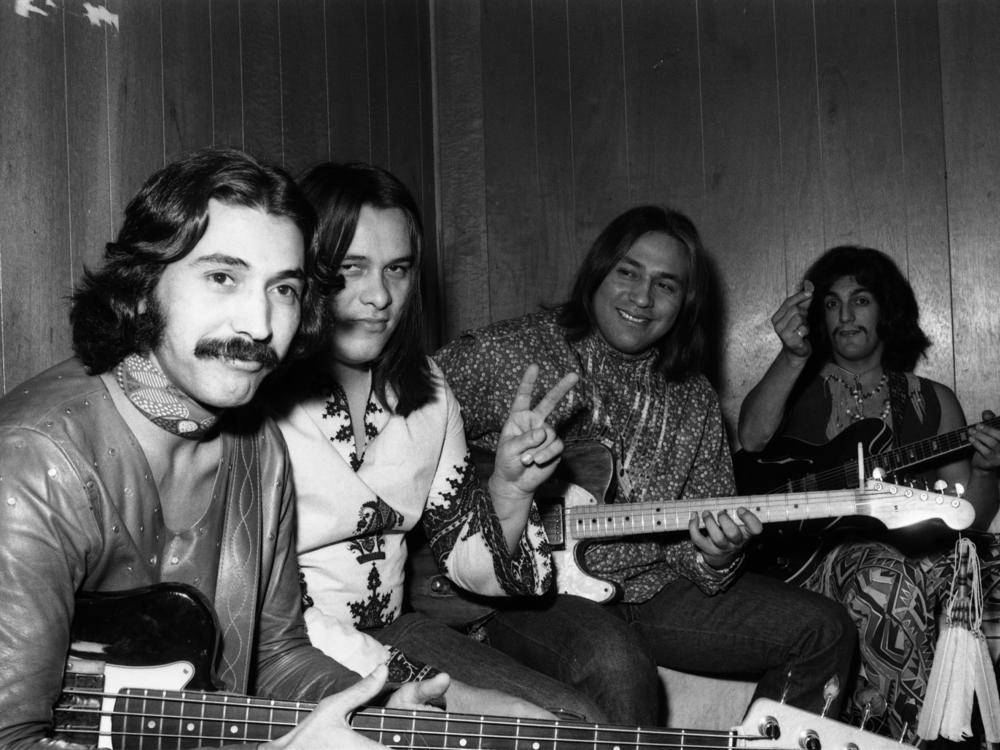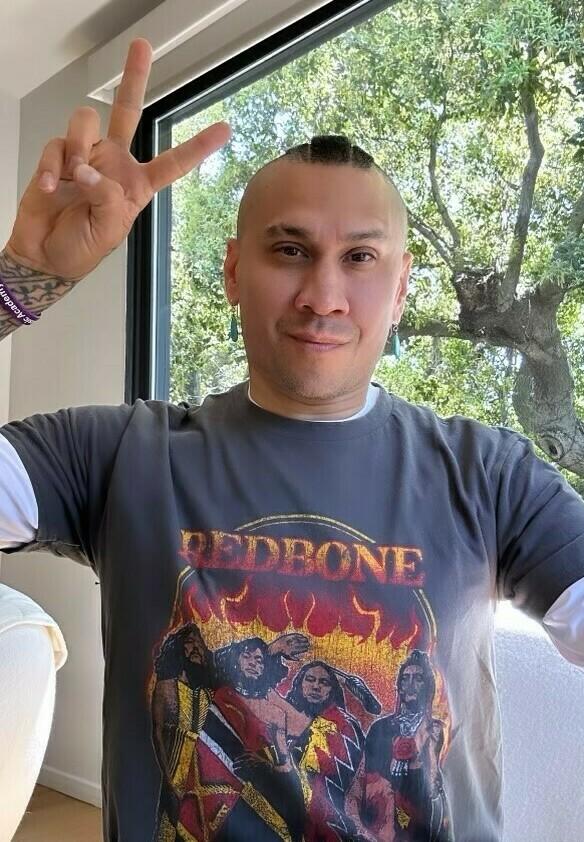Section Branding
Header Content
50 years ago, 'Come and Get Your Love' put Native culture on the bandstand
Primary Content
Fifty years ago this month, President Richard Nixon was facing impeachment. Hank Aaron broke Babe Ruth's home run record. Leaders of the American Indian Movement were on trial after the armed standoff at Wounded Knee. And the song "Come and Get Your Love" was one of the biggest hits on the radio.
This soulful pop tune by the band Redbone was, in some ways, related to what was going on politically. It became the first song by an all-Native and Mexican American band to crack the Billboard Top 10, peaking at No. 5 on April 13, 1974.
Since its release on Redbone's 1973 album Wovoka, "Come and Get Your Love" has been used in commercials, on TV shows including the Netflix series F Is for Family and in movies. The song captured a new generation of fans in 2014, when actor Chris Pratt danced to it in the opening scene of Marvel's Guardians of the Galaxy.
Musician Stevie Salas remembers first hearing "Come and Get Your Love" as a sixth grader in Oceanside, Calif., where it came on during a school dance. Salas, who is Apache, has played guitar with musicians such as Rod Stewart, Bootsy Collins, Mick Jagger and Justin Timberlake. He's also an executive producer on a documentary about Native musicians called Rumble: Indians Who Rocked The World. But back in sixth grade, he had no idea the musicians behind "Come and Get Your Love" were Native and Mexican American — until he saw them on TV.
"Redbone came on and they were all dressed like Natives. I mean, that was just mind-blowing," Salas recalls. "But at the same time, you'd see people dressed like that, you know, on Halloween. So I don't know, are they real Indians? It's like that. But they sure look cool."
The pompadour years
Redbone's founders had always cultivated a striking look, though the decision to showcase their Native culture onstage took time.
Brothers Pat and Lolly Vasquez grew up in Fresno, Calif. According to Pat's memoir, their mother was Shoshone, while their father had both Mexican and Native roots including Yaqui, Papago and Navajo. Their maternal grandfather was a musician from Texarkana who played Cajun and Mariachi music, and who taught Pat and Lolly to play guitar. When the brothers started playing as a duo, Pat switched to bass.
In the late 1950s, the two started playing gigs in and around Los Angeles, from sock hops to family picnics. After a music industry veteran recommended they change their surname to appeal to white talent bookers, they put a spin on their stepfather's name, De La Vega, rebranding as Pat & Lolly Vegas. Their stage style in this era was suits and slicked-back pompadours: "We used to get our hair done and all this stuff. We had a real straight look," remembers Pat Vegas, who, at 83, is the last surviving original member of Redbone. (Lolly died in 2010.)
In addition to the club gigs, the Vegas brothers were session musicians and songwriters. They appeared in the 1967 beach comedy It's a Bikini World, and teamed up with other musicians to record surf music under the name The Avantis.
The Vegas brothers were successful making music that appealed to the mainstream. But they were also inspired by the Civil Rights movement, and by Native activists who were calling out the poverty on reservations, broken treaties and other injustices. "Our friends were going out there and marching and protesting," Pat Vegas says, explaining that as entertainers, they wanted to show the world a more accurate depiction of Native people. "Because it was being overlooked. They saw us in Western movies being chased by the cowboys, and we didn't want to be a part of that. We wanted to show that we had grown and we were part of the future."
Pat & Lolly Vegas eventually ditched the pompadours, and set out to form a band of all Native and Mexican American players. They were joined by rhythm guitarist Tony Bellamy, who was of Mexican and Yaqui descent, and drummer Pete DePoe, who was Cheyenne. They grew their hair long, and began performing in Native dress on stage. The choice wasn't just a reaction to the politics of the moment, Vegas says — it was who they were.
"My mom was proud of her Native American roots, and I was too," he says. "So automatically, we knew what we wanted, and the sound came out that way, and it was beautiful. I just wanted to be real."
A sound both political and "all about love"
The new group called itself Redbone, a slang term that some might find offensive, though the members said they used it to mean mixed race. The band signed with Epic Records and set about creating its own sound, what Vegas has called "Native American swamp rock."
In 1973, a group of Native activists occupied the town of Wounded Knee in South Dakota — the same site where, 83 years earlier, hundreds of Lakota had been massacred by U.S. soldiers. Pat Vegas says he "felt the struggle," and wanted to contribute.
For Redbone's album Wovoka, Vegas wrote the song "We Were All Wounded at Wounded Knee." The song became a hit in Europe, but CBS refused to release it in the U.S., fearing it was too controversial. Vegas has said that he understood the company's reasoning and that he wasn't angry (though some scholars, like University of Idaho professor Jan Johnson, have called it a missed opportunity and an example of "historical amnesia" around events that make us uncomfortable).
There was, however, another song on Wovoka that the label thought could be a hit. As Pat Vegas tells it, he and his brother worked on "Come and Get Your Love" late one night in Philadelphia, where they were performing a series of gigs. It was finished the next day.
In his memoir, Pat claims that the song was co-written by the two of them, but that Lolly claimed sole credit for it with the label. He writes that while he was "appalled" and "furious" with his brother, he chose to stay silent, believing that raising a stink would hurt Redbone's reputation. When I asked how the disagreement affected their relationship, he says, "We got over it."
"A sound that was so inclusive"
"Come and Get Your Love" spent 18 weeks in the Top 40 and was the fourth most popular song of Billboard's Hot 100 for 1974. In the years since, its presence has continued to echo through pop: The Eurodance group Real McCoy released a club-ready cover, Cyndi Lauper updated her own "Girls Just Want to Have Fun" by mashing it up with Redbone's hit — and, in 2020, Sony's Legacy Recordings released the song's first official music video, an animated short by Native artist Brent Learned and producer and director Juan E Bedolla.
In the 1970s, the song's massive popularity gave the members of Redbone a platform to show pride in their Native heritage. Rapper Taboo Nawasha of chart toppers the Black Eyed Peas says that's what he, another musician of Native and Mexican ancestry, strives for in his music.
"With a sound that was so inclusive, ['Come and Get Your Love'] was for everyone to come and rock out," Nawasha says. "Redbone kicked down the door and said, 'We're proud to be Native, check us out. We're here, we're alive and we're going to bring that great energy and that good medicine to the world.' "
Reflecting on the song 50 years later, Pat Vegas says a lot of people think "Come and Get Your Love" is about romance. They're not entirely wrong — but there's more to it than that.
"It's love all around, in every facet and every part of your being, you know?" he says. "And that's the message: What's the matter with your mind and your sign? Come and get your love. In other words, where you come from and who you are doesn't matter as much as what you believe, and what you feel."
The audio version of this story was edited by Rose Friedman and produced by Isabella Gomez Sarmiento. The digital version was edited by Daoud Tyler-Ameen.


